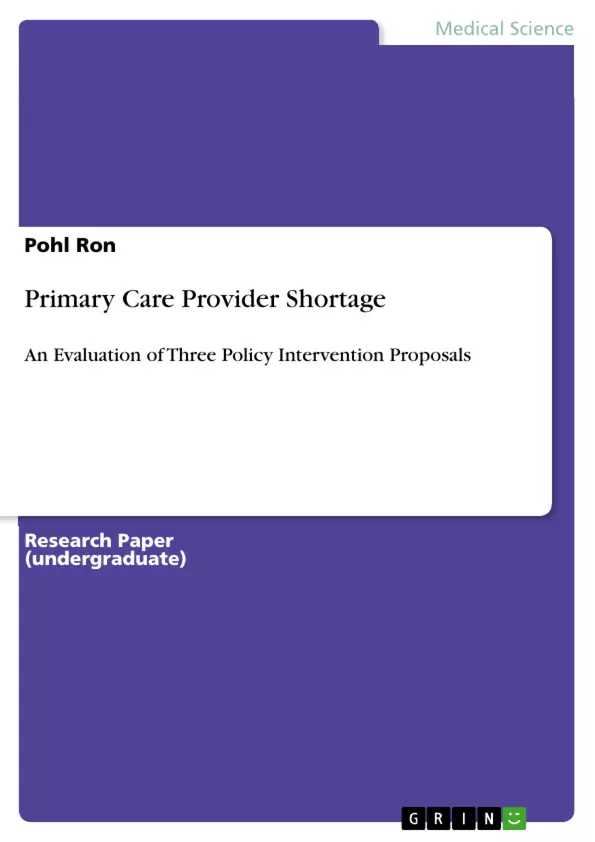We are proposing the following solutions to the challenge of primary healthcare provider shortages in rural Washington: that undergraduate medical education (UME) pathway in the two medical schools in the state be altered; visa-waivers, loan-forgiveness and direct incentive programs expanded; and residency funding be increased. These are workable with the right support and resources.
We understand that primary healthcare physician shortages will worsen more and more over the next decade if nothing is done now; and there is no doubt that communities have been feeling the impacts of shortages. Since none of the plans proposed here can work to reduce the expected decrease, the right combination of strategies will results in an increase in the number of primary healthcare physicians per population in rural Washington, which is the main aim of this proposal.
Inhaltsverzeichnis (Table of Contents)
- Executive Summary
- Organization Information
- Background
- Statement of Need
- Proposed Plan
- Plan 1: Altering the undergraduate medical education (UME) pathway in the two medical schools in the state
- Plan 2: Increasing visa-waivers and improving loan-forgiveness and direct incentive programs
- Plan 3: Increase residency funding
- Project Evaluation
- Conclusion
- Sources cited
Zielsetzung und Themenschwerpunkte (Objectives and Key Themes)
This proposal aims to address the primary healthcare provider shortages in rural Washington by recommending solutions such as altering the undergraduate medical education (UME) pathway, expanding visa-waivers and loan-forgiveness programs, and increasing residency funding. The ultimate goal is to increase the number of primary healthcare physicians per population in rural Washington, ensuring improved health outcomes and addressing the growing need for primary care services in these communities.
- Primary healthcare provider shortage in rural Washington
- Impact of shortage on patient access and health outcomes
- Proposed solutions to address the shortage
- Evaluation of proposed plans
- Importance of primary care in achieving health equity
Zusammenfassung der Kapitel (Chapter Summaries)
- Executive Summary: Outlines the proposal's focus on addressing primary healthcare provider shortages in rural Washington through a combination of strategies such as altering the UME pathway, expanding visa-waivers and loan-forgiveness programs, and increasing residency funding. The objective is to increase the number of primary healthcare physicians per population in rural Washington.
- Organization Information: Introduces Neon Healthcare Research, a non-profit organization dedicated to improving public health policies through research and scientific solutions. The organization emphasizes its broad research portfolio and specific focus on health areas like organizing patient care, payment for healthcare, and healthy communities. The recipient organization is identified as the Washington State legislature, highlighting the need for research-based support to address primary care shortages.
- Background: Explains the importance of primary healthcare in building strong healthcare systems and achieving health equity. The section highlights the shift towards individual/family-oriented and community-focused healthcare services. The concept of primary healthcare provider shortage is defined, along with relevant statistics and existing challenges.
- Statement of Need: Examines the consequences of primary healthcare provider shortages in rural Washington, emphasizing the potential impact on patients and communities. The section underscores the importance of a robust primary healthcare workforce for improving health outcomes, preventive care, and reducing health inequalities. The statement also acknowledges previous policy interventions and identifies potential opportunities for implementing change.
- Proposed Plan: This section outlines the proposed solutions to address the primary care provider shortage. Plan 1 focuses on altering the undergraduate medical education (UME) pathway in the two medical schools in the state. Plan 2 proposes expanding visa-waivers and loan-forgiveness programs. Finally, Plan 3 suggests increasing residency funding.
Schlüsselwörter (Keywords)
Key terms and concepts explored in the document include primary healthcare provider shortage, rural healthcare, undergraduate medical education (UME), visa-waivers, loan-forgiveness programs, residency funding, health equity, health outcomes, preventive healthcare, and policy interventions.
- Quote paper
- Pohl Ron (Author), 2017, Primary Care Provider Shortage, Munich, GRIN Verlag, https://www.grin.com/document/353514



